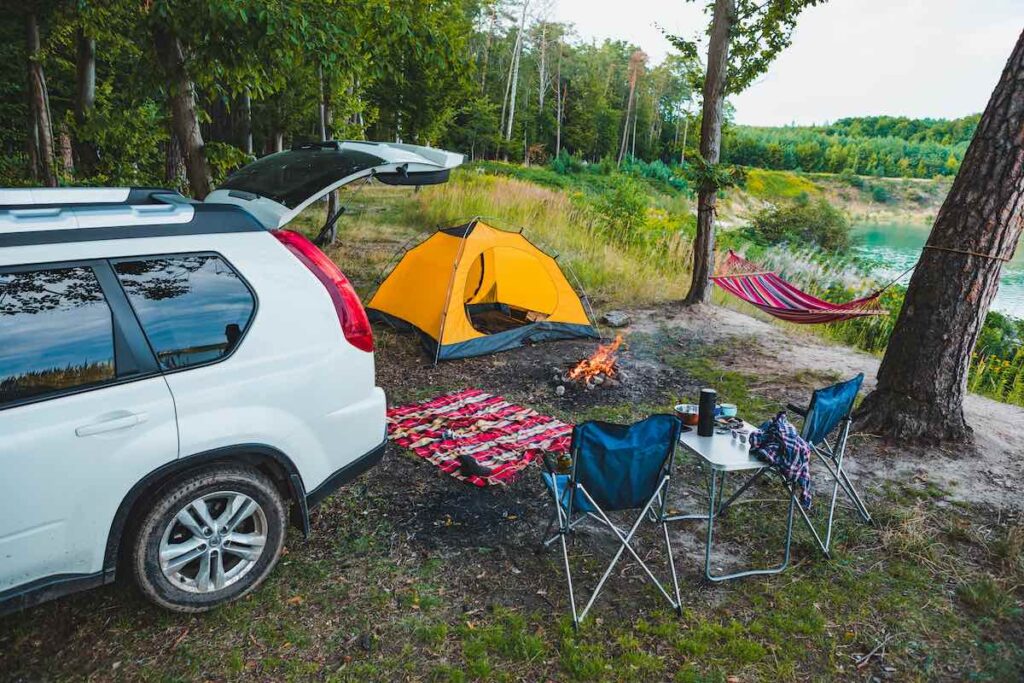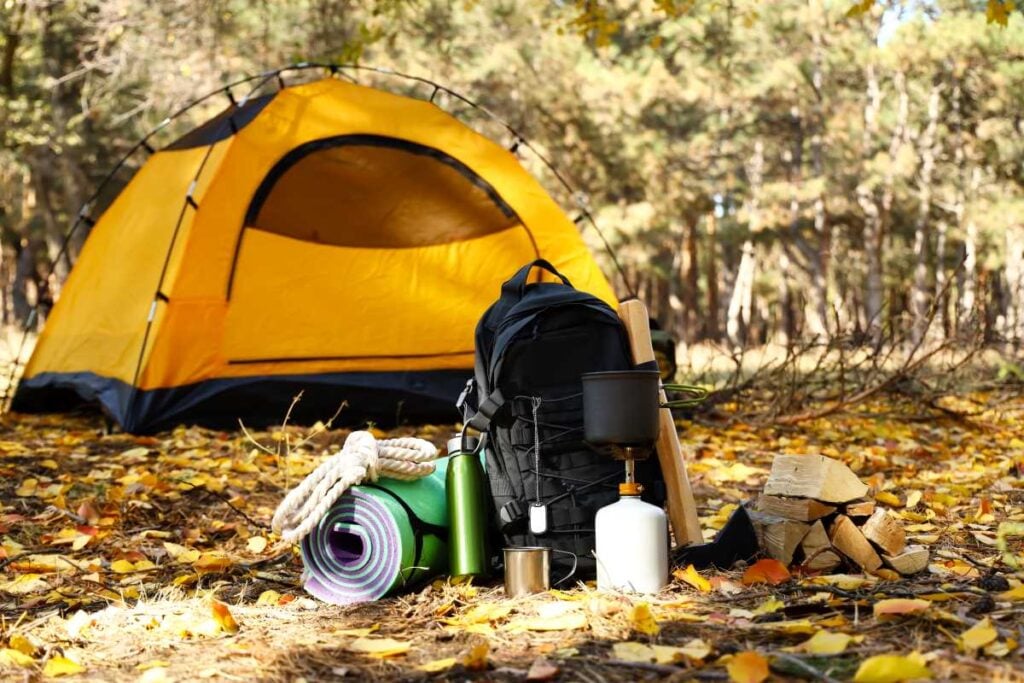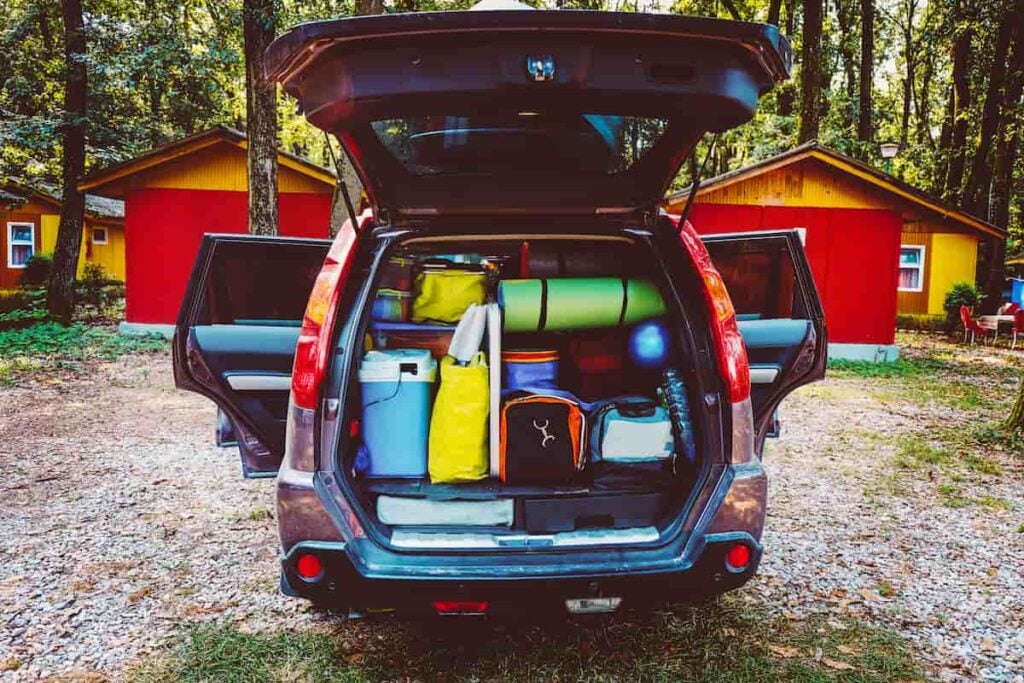No matter the season, it’s always fun to start dreaming up your next memory-making vacation. Whether you’re traveling solo, with a partner or friends, or dragging the whole family along, a camping road trip should be on your vacation bucket list.
Road trip camping is inexpensive compared to other vacations, and you have much more flexibility. Driving past the world’s largest ball of yarn? Stop and check it out! Not feeling like putting in the planned miles that day? Don’t!
Read on to learn all you need to know for planning a camping road trip.

Destinations
First and foremost, pick a destination for your camping road trip. Select a campsite and make a reservation, if needed, before you actually set out on your trip, and then plan ahead as needed on the road (unless you want to keep to a strict schedule and book all your campsites well in advance).
Once you have an ultimate end point in mind, pull out (or pull up on your computer) a map that shows where you’re starting and where you plan to go. This will help you narrow down your list of must-see attractions and show you the camping potential along the way.
Road-trip Planning Apps

Even if you prefer to go old school and plan your trip on a paper map with a pencil, it’s a good idea to check out one of the many road-trip planning apps available. This technology can help you locate points of interest as well as camp and rest sites, and can give you some basic information on your route.
Roadtrippers is one of the most comprehensive sources that can help you get the most out of your road trip camping vacation. On the web or via the app, Roadtrippers lets you map out your route and pins different points of interest along the way, like restaurants, attractions, and scenic stops. You can filter points of interest to see only the ones that interest you, and you can add your own waypoints, as well.
Try the free version. If you really love it, you can upgrade to plus which will get you features like offline maps and live traffic.
Another great free resource for planning a camping road trip is Recreation.gov and its mobile app. With this app, you can compare campsites and check availability, see real-time notices and closure information, book tickets for tours and activities, and even enter lotteries for popular attractions.
The app also allows users who have booked a campsite to scan and pay upon arrival, rather than hassle with cash or a credit card (scan and pay even works when there’s no or spotty cell service!).
Saving Locations in Google Maps
If you don’t want to mess with an app but still want some electronic guidance, you can plot your route and pin attractions in Google Maps.
First, make sure you’re logged in to Google so you can access and update your map as needed on the go.
Next, search for a destination you want to visit, like a certain campground. When the search results come back, under the “directions” tab, click “save.” All your saving options will appear, and you can customize as you see fit, even choosing different icons for different points of interest.
Rinse and repeat for all other stops you might want to make.
Download Google Maps for the area in which you’re traveling before setting out to ensure you have access to a map even when you don’t have cell service. To do this, follow these instructions.
- When logged in to Google Maps, tap your profile picture (or initial).
- Select “offline maps.”
- Choose “select your own map.”
- Adjust according to the area you want to download.
- Select “download.”
Reservations, Permits, and Camp Costs

Any private campsite you book will definitely charge a fee, which can range from $12 to $45 per night, depending on the area and amenities. That definitely beats the cost of a hotel room, and you’ll get to sleep under the stars instead of below a noisy guest in the room above yours!
Most Bureau of Land Management (BLM) and US Forest Service camping areas allow visitors to stay for up to 14 days. Sites are usually first come, first served, and you may need to purchase a permit or pay a fee to camp, so it’s a good idea to check the campground’s website or give the contact number a call before you show up.
These public land camp areas also often allow “dispersed” camping, which means you’ll be pitching your tent away from developed recreation facilities (like restrooms). These are pack-it-in, pack-it-out sites; you won’t find any garbage cans around, so take your trash with you.
National Parks typically require reservations for camping, and sites may be sold out months in advance. The campgrounds tend to be more crowded, but the proximity to the park may make the lack of privacy worth it.
You will need an entrance pass to camp at a national park, but once you buy one, it’s good for any national park for at least the next 12 months.
Season

Before you head out on your epic camping road trip, plan appropriately for the season. For example, it’s probably not the best idea to plan a camping road trip through the northeast United States in the middle of winter.
If you plan to camp in an unfamiliar region, do a little advance research to give you an idea of the weather. Although camping in the summer in the Pacific Northwest may be amazing, that’s not the case for summer camping in the Mid-Atlantic, where the heat and humidity can make the inside of a tent feel like a sauna.
Remember, too, that your vehicle may not be equipped to handle some camping areas in certain seasons. So while you might feel fine about snow camping, your vehicle may not be fine getting you to and from the campsite.
Car Maintenance

This brings us to another important task to take care of before your camping road trip: car maintenance. Make sure to get your car checked and serviced before heading out. The last thing you want to do on your vacation is deal with a breakdown.
Even simple things, like getting a fluid check and changing the air filters, can ensure your vehicle is ready to go.
And, of course, gas up before you hit the road and maintain awareness of your fuel level. It’s a good idea to top off your tank as you pass through towns, just in case.
How to Pack for a Camping Road trip
How you pack for your road trip camping adventure depends on a few key factors: weather, planned activities, and duration.
Clothing and Personal Gear
If you’re camping during a rainy or colder season, you’ll want to make sure you have the appropriate rain gear, including a water-resistant jacket and at least one extra pair of shoes. You’ll also want clothing you can layer, especially if your plans involve a lot of outdoor activities, like hiking. Check the outlet stores of your favorite retailer if you need to buy new stuff.
Remember to bring a few plastic bags to stash wet or muddy clothes.
General Supplies

Storage Crates
Plastic storage bins and crates keep things organized, which is very important on a camping road trip so you can maximize car space. Consider putting all your dry food in one crate, cooking supplies, and light sources (like headlamps and flashlights) in one, and perhaps board games or other campsite entertainment in another. Label each box, so it’s easy to find what you’re looking for without unpacking the entire car.
Cooking Equipment
Cooking your own food on your road trip camping adventure can be both fun and money-saving. You’ll need to pack at least one pot, one pan, and a metal or wooden spatula and spoon. Make sure you bring cookware that can withstand the heat of a camp stove or a fire, and leave your best skillet and such at home. You can also purchase a camp cook set.
Remember to bring paper, plastic, or reusable plates, bowls, utensils, dish soap, and a sponge.
Food
For a camping road trip, even eating just one meal at the campsite each day can save you a ton of money.
Pack a cooler with plenty of ice (refill the ice along the route as it melts) and stash your perishables in it–milk, eggs, cheese, and meats (wrapped well to prevent contaminating the other foods). Grab a box or plastic storage crate for your dry ingredients–bread, pancake mix, condiments, etc. To save on space, just pack enough food for a day or so and plan on stopping en route to replenish your supplies (this prevents you from wasting unused food, too).
Sleep Gear
A sleeping bag (if it’s going to be super cold overnight, consider a sleeping bag rated for colder temperatures) or blanket and a pillow are essential for your camping road trip.
Consider using a camp or travel pillow to save some car space, and maybe a sleep mat to make ground sleeping more comfortable. You can find lots of options online, from egg-carton foam to self-inflating.
Foam earplugs and a nighttime eye mask can help you get good rest on the road, as well; especially if you end up at a crowded campground with noisy neighbors. Likewise, a battery-powered or rechargeable camping fan can be a lifesaver if you end up in a hot tent.
Packing the Car

Packing the car sensibly can enhance your road trip camping experience. First and foremost, remember that the people riding in the car will be spending a good amount of time in it, so allow as much space per person as possible.
When loading your supplies, start with the things you’ll need last in the hardest-to-access area (for example, if you’re loading a car trunk, put these items in first toward the back of the trunk). Build out from there in order of probable need. So, for instance, pack your tent and sleeping bags before your clothing, and your clothing before any snacks or other items you might want to grab en route. If you’re camping with pets, keep a water jug, bowl, and food near the opening of your trunk or hatch so you can easily allow your companion to drink some water and have a snack when you have to pull into a rest stop because your kid has to pee for the fourteenth time in an hour.
Keeping a bag or box of food and other in-car essentials (charging cords, books, car games, paper towels) in a specific spot in your vehicle can help eliminate the need to disturb what’s likely your expertly tetris-ed trunk.
Also keep a few car maintenance basics handy, like a quart of oil, tire-pressure gauge, wiper fluid, and even something to use for an emergency flat repair. If you’re traveling in winter or in a colder area, pack tire chains.
Have Fun Planning a Camping Road Trip!

With a little planning and a sense of adventure, a camping road trip can be one of the best vacations you’ll ever take. Luckily, plenty of apps and online resources make route planning and site-seeing easy.
Once you start looking into it, you’ll discover how much fun planning a camping road trip can be. You’ll discover landmarks you never knew existed, and you can take the time to check them out.
The best thing about a camping road trip is the flexibility to do as much (or as little) as you want in a day, and end each night under the stars, surrounded by nature and the promise of a new adventure tomorrow.
For more camping ideas and tips, visit the Camping page on our website!

